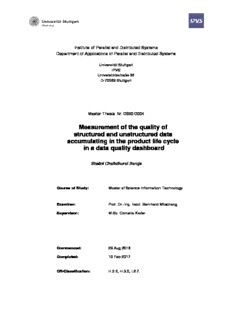
Measurement of the quality of structured and unstructured data accumulating in the product life ... PDF
Preview Measurement of the quality of structured and unstructured data accumulating in the product life ...
Institute of Parallel and Distributed Systems Department of Applications of Parallel and Distributed Systems Universität Stuttgart IPVS Universitätsstraße 38 D-70569 Stuttgart Master Thesis Nr. 0990-0004 Measurement of the quality of structured and unstructured data accumulating in the product life cycle in a data quality dashboard Shalini Chellathurai Saroja Course of Study: Master of Science Information Technology Examiner: Prof. Dr.-Ing. habil. Bernhard Mitschang Supervisor: M.Sc. Cornelia Kiefer Commenced: 29 Aug 2016 Completed: 10 Feb 2017 CR-Classification: H.2.8, H.3.5, I.2.7. ABSTRACT This thesis provides an overview on existing data quality metrics for structured and unstructured data as well as on the existing data quality dashboards for measuring the quality of structured and unstructured data. Open research questions for interpreting the data quality are discussed. The metrics percentage of null values, percentage of duplicate values and percentage of non-domain values were selected and implemented as REST based web services. Furthermore, a web application was developed to enable (1) upload of the data file for which data quality shall be assessed from two standard formats JSON and CSV and (2) flexible integration of various data quality metrics. The latter is enabled by using an interface. To illustrate the functionality of this interface, the metric percentage of spelling mistakes provided by the supervisor of the thesis is integrated with the web application. The data quality is indicated as percentage in the range from 0 to 100 as well as encoded with colors for the whole dataset and for each column. Donut chart or pie chart visualizations are implemented for the chosen data quality metrics. The implemented web application and metrics were evaluated with the example datasets for data accumulating in the product life cycle as provided by the supervisor. Finally, the dashboard is compared with existing data quality dashboards and the results are tabulated. i ii ACKNOWLEDGEMENTS I thank Prof. Dr.-Ing. habil. Bernhard Mitschang for providing me an opportunity to work on my thesis in the Department of Applications of Parallel and Distributed Systems. I express my deepest gratitude to my supervisor M.Sc. Cornelia Kiefer for guiding, motivating and supporting me throughout the entire duration of the thesis. I am extremely fortunate to work with her. I thank my husband Pradeep Parameshwaran and my family for encouraging and supporting me throughout the thesis. iii iv TABLE OF CONTENTS ABSTRACT ............................................................................................................................................. i ACKNOWLEDGEMENTS ................................................................................................................... iii TABLE OF CONTENTS ........................................................................................................................ v LIST OF FIGURES ............................................................................................................................... ix LIST OF TABLES ................................................................................................................................. xi LIST OF SCREENSHOTS .................................................................................................................. xiii ABBREVIATIONS .............................................................................................................................. xv 1 INTRODUCTION .......................................................................................................................... 1 1.1 Research Question .................................................................................................................. 1 1.2 Thesis Organization ................................................................................................................ 2 2 BACKGROUND ............................................................................................................................ 3 2.1 Data ......................................................................................................................................... 3 2.2 Data Quality ............................................................................................................................ 4 2.3 Data Quality Dimensions ........................................................................................................ 4 2.3.1 Accuracy ......................................................................................................................... 4 2.3.2 Completeness .................................................................................................................. 5 2.3.3 Validity ........................................................................................................................... 5 2.3.4 Consistency ..................................................................................................................... 5 2.3.5 Currency .......................................................................................................................... 6 2.3.6 Interpretability ................................................................................................................. 6 2.3.7 Relevancy ........................................................................................................................ 6 2.4 Product Life Cycle .................................................................................................................. 6 2.5 Data Visualization ................................................................................................................... 6 2.6 RESTful Web Service ............................................................................................................. 8 3 RELATED WORK ......................................................................................................................... 9 3.1 Existing Data Quality Dashboards .......................................................................................... 9 3.1.1 IBM Watson Analytics .................................................................................................... 9 3.1.2 Data Analyzer by Uniserv ............................................................................................. 10 3.1.3 Data Quality Scorecard by Uniserv............................................................................... 11 3.1.4 Data Quality Dashboard and Reporting by Informatica ................................................ 11 3.1.5 Data Quality Analysis Dashboard Package by Salesforce ............................................ 12 3.1.6 Data Quality Dashboards by Talend ............................................................................. 13 3.1.7 DQ Dashboard by Attacama ......................................................................................... 13 3.1.8 Data Quality Dashboard by InsightSquared .................................................................. 13 3.1.9 Data Governance Center 4.5 by Collibra ...................................................................... 14 v 3.2 Comparison of Data Quality Dashboards ............................................................................. 16 3.3 Prototypes of Data Quality Dashboards ................................................................................ 17 3.4 Open Research Issues............................................................................................................ 18 4 DATA QUALITY METRICS ...................................................................................................... 19 4.1 Overview on Data Quality Methodologies ........................................................................... 19 4.2 Assessing the Quality of Unstructured Data ......................................................................... 20 4.3 Completeness ........................................................................................................................ 22 4.3.1 Percentage of null values .............................................................................................. 22 4.3.2 Percentage of default values ......................................................................................... 23 4.3.3 Percentage of duplicate values ...................................................................................... 23 4.4 Validity ................................................................................................................................. 24 4.4.1 Percentage of non-domain values ................................................................................. 24 4.4.2 Percentage of non-range values .................................................................................... 24 4.4.3 Percentage of outliers .................................................................................................... 25 4.5 Consistency ........................................................................................................................... 25 4.5.1 Percentage of inconsistent format in a field .................................................................. 25 4.6 Interpretability ....................................................................................................................... 26 4.6.1 Percentage of spelling mistakes .................................................................................... 26 4.6.2 Fit of training data ......................................................................................................... 26 4.7 Relevancy .............................................................................................................................. 26 4.7.1 Percentage of non-relevant data .................................................................................... 26 5 CONCEPT .................................................................................................................................... 29 5.1 Architecture ........................................................................................................................... 29 5.1.1 High Level Generic Architecture .................................................................................. 29 5.1.2 High Level Specific Architecture.................................................................................. 29 5.1.3 Low Level Architecture ................................................................................................ 31 6 IMPLEMENTATION ................................................................................................................... 33 6.1 Libraries ................................................................................................................................ 33 6.1.1 AngularJS ...................................................................................................................... 33 6.1.2 Data Driven Documents (D3) ....................................................................................... 33 6.1.3 NVD3 ............................................................................................................................ 33 6.1.4 Angular-nvD3 ............................................................................................................... 34 6.1.5 Bootstrap ....................................................................................................................... 34 6.1.6 Apache Tomcat ............................................................................................................. 34 6.1.7 CherryPy ....................................................................................................................... 34 6.1.8 Jersey ............................................................................................................................. 34 vi 6.1.9 JSON-Simple ................................................................................................................ 34 6.1.10 Duplicate Detection Toolkit .......................................................................................... 34 6.1.11 PyEnchant ..................................................................................................................... 35 6.2 Implementation Details of the Web Front End ..................................................................... 35 6.2.1 Upload Module ............................................................................................................. 35 6.2.2 Metric Modules ............................................................................................................. 36 6.2.3 Metric Interface ............................................................................................................. 36 6.2.4 User-defined Calculation of Overall DQ ...................................................................... 37 6.2.5 Visualizations ................................................................................................................ 37 6.3 Instructions to Integrate New Metrics ................................................................................... 38 6.4 Web Services ........................................................................................................................ 38 6.4.1 Null Value Web Service ............................................................................................... 38 6.4.2 Duplicate Value Web Service ....................................................................................... 39 6.4.3 Non-Domain Value Web Service.................................................................................. 39 6.4.4 Spelling Mistakes Web Service .................................................................................... 40 6.4.5 Convert to JSON file Web Service ............................................................................... 40 6.5 User Interface ........................................................................................................................ 40 7 DEMONSTRATION AND EVALUATION ................................................................................ 43 7.1 Datasets ................................................................................................................................. 43 7.2 Analysis of the Quality of the Datasets with the Dashboard ................................................ 43 7.2.1 Analysis of the NHTSA Consumer Complaints Dataset .............................................. 44 7.2.2 Analysis of DuDe Restaurant Dataset ........................................................................... 48 7.2.3 Analysis of Twitter Dataset ........................................................................................... 48 7.2.4 Analysis of News Dataset ............................................................................................. 48 8 CONCLUSION AND FUTURE WORK...................................................................................... 51 9 APPENDIX ................................................................................................................................... 53 REFERENCES ..................................................................................................................................... 57 vii viii
Description: